-
 Microbial Load of Hand Sanitizer Dispensers—A University Hospital Study
Microbial Load of Hand Sanitizer Dispensers—A University Hospital Study -
 Improving Health Literacy of Domestic Household Disinfection Use: Readability of Consumer-Facing Information on Domestic Household Disinfectant Products on Sale in the UK—An Infodemiology Study
Improving Health Literacy of Domestic Household Disinfection Use: Readability of Consumer-Facing Information on Domestic Household Disinfectant Products on Sale in the UK—An Infodemiology Study -
 Maternal Handwashing with Soap Practices and Associated Risk Factors in Nepal: A Systematic Review
Maternal Handwashing with Soap Practices and Associated Risk Factors in Nepal: A Systematic Review
Journal Description
Hygiene
Hygiene
is an international, peer-reviewed, open access journal on healthcare epidemiology, public health and environmentally-related hygiene, published quarterly online by MDPI. We also welcome submissions with a focus on best practices that help maintain health and prevent the spread of diseases.
- Open Access— free for readers, with article processing charges (APC) paid by authors or their institutions.
- Rapid Publication: manuscripts are peer-reviewed and a first decision is provided to authors approximately 14.9 days after submission; acceptance to publication is undertaken in 3.5 days (median values for papers published in this journal in the second half of 2023).
- Recognition of Reviewers: APC discount vouchers, optional signed peer review, and reviewer names published annually in the journal.
Latest Articles
Ralstonia insidiosa Bacteremia in Patients with Solid Cancer Treated by Means of a Central Venous Catheter
Hygiene 2024, 4(2), 157-163; https://doi.org/10.3390/hygiene4020012 - 17 Apr 2024
Abstract
Ralstonia spp. are low-virulent environmental Gram-negative bacteria that can cause serious nosocomial infections in immunocompromised patients. We report the characteristics of a cluster of R. insidiosa bacteremia cases occurring in our oncology day ward in Milan, Italy, between January and March 2022. A
[...] Read more.
Ralstonia spp. are low-virulent environmental Gram-negative bacteria that can cause serious nosocomial infections in immunocompromised patients. We report the characteristics of a cluster of R. insidiosa bacteremia cases occurring in our oncology day ward in Milan, Italy, between January and March 2022. A case was defined as a cancer patient attending our day ward and whose blood culture (performed because of bacteremia symptoms) led to the isolation of Ralstonia insidiosa. An epidemiological investigation was conducted in order to seek the possible source of infection. Seven adult patients received curative or palliative treatment via infusion through a Port-a-Cath (PAC). All developed symptoms within 24 h of the infusion (three during the infusion itself). Ralstonia insidiosa was isolated in the blood drawn from the PAC in all patients. All of the isolates were susceptible to carbapenems, fluoroquinolones, and piperacillin/tazobactam but resistant to aminoglycosides and cephalosporins. Systemic and/or lock antibiotic therapy led to stable symptom resolution and negative blood cultures in five patients, whereas bacteremia recurred in two patients. An epidemiological investigation suggested that extrinsic contamination of antiseptic solutions was the possible cause of the R. insidiosa infections. Although R. insidiosa is not considered a virulent pathogen, clinicians, microbiologists, and infection control teams should be aware about its potential to cause outbreaks of nosocomial bloodstream infections, especially in immunocompromised patients bearing central venous catheters.
Full article
(This article belongs to the Section Infectious Disease Epidemiology, Prevention and Control)
►
Show Figures
Open AccessArticle
Formation/Removal of Biofilms on/from Coupons of Selected Food-Grade Elastomeric Polymers vs. Plexiglass Used for the Fruit-Catching Plates of OTR Blueberry Machine Harvesters
by
Peien Wang, Minji Hur, Lisa Wasko DeVetter, Fumiomi Takeda and Jinru Chen
Hygiene 2024, 4(2), 146-156; https://doi.org/10.3390/hygiene4020011 - 11 Apr 2024
Abstract
To reduce the bruising potential of machine-harvested fresh blueberries, manufacturers of over-the-row (OTR) machine harvesters are replacing the hard, plexiglass fruit-catching plates with soft, elastomeric polymers. This study assessed whether selected soft, food-grade elastomeric polymers, with the potential to be used in OTR
[...] Read more.
To reduce the bruising potential of machine-harvested fresh blueberries, manufacturers of over-the-row (OTR) machine harvesters are replacing the hard, plexiglass fruit-catching plates with soft, elastomeric polymers. This study assessed whether selected soft, food-grade elastomeric polymers, with the potential to be used in OTR harvesters, have a greater likelihood to encourage more microbial buildups, making cleaning/sanitation a greater challenge. Coupons of plexiglass, silicone, neoprene, and ethylene propylene diene monomer (EPDM) were exposed to fecal coliforms from various sources for biofilm development. The coupons with developed biofilms were treated with sodium hypochlorite, peracetic acid, isopropyl alcohol-based quaternary ammonium compounds (Alpet D2), or commercial dish soap. Biofilms and their residuals after the sanitizer treatments were quantified. The fecal coliforms isolated from the surface of OTR harvesters developed significantly (p ≤ 0.05) more biofilms than those from other sources. EPDM coupons had significantly more, while neoprene and silicone coupons had insignificantly different (p > 0.05) amounts of biofilms from plexiglass coupons. After sanitizer treatments, EPDM coupons had significantly more, while neoprene and certain silicon coupons had significantly fewer residues than plexiglass coupons. Study suggests that compared to plexiglass, neoprene and silicon did not support more microbial buildups or retain more biofilms after sanitizing treatments.
Full article
(This article belongs to the Section Food Hygiene and Safety)
►▼
Show Figures
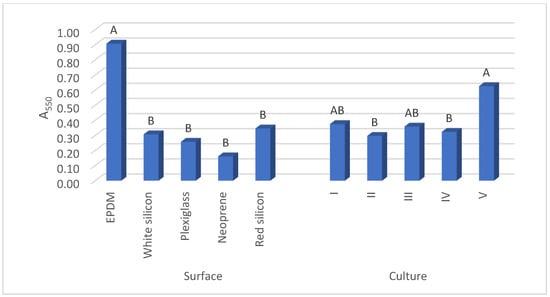
Figure 1
Open AccessArticle
Antimicrobial Properties of Basil (Ocimum basilicum L.), Sage (Salvia officinalis L.), Lavender (Lavandula officinalis L.), Immortelle (Helichrysum italicum (Roth) G. Don), and Savory (Satureja montana L.) and Their Application in Hard Cheese Production
by
Nevijo Zdolec, Marijana Franičević, Lucija Klanac, Ivana Kavain, Josip Batinić, Manuela Zadravec, Jelka Pleadin, Darko Čobanov and Marta Kiš
Hygiene 2024, 4(2), 135-145; https://doi.org/10.3390/hygiene4020010 - 29 Mar 2024
Abstract
The aim of the study was to evaluate the antimicrobial activity of the extracted plants basil (Ocimum basilicum L.), sage (Salvia officinalis L.), lavender (Lavandula officinalis L.), immortelle (Helichrysum italicum (Roth) G. Don), savory (Satureja montana L.), and
[...] Read more.
The aim of the study was to evaluate the antimicrobial activity of the extracted plants basil (Ocimum basilicum L.), sage (Salvia officinalis L.), lavender (Lavandula officinalis L.), immortelle (Helichrysum italicum (Roth) G. Don), savory (Satureja montana L.), and rosemary (Salvia rosmarinus Spenn.) against foodborne and clinical pathogens. Dried plants were used in the production of Dalmatian cow’s milk hard cheese at concentrations of 0.5, 1.0, 1.5, and 2% to evaluate the microbiological safety and sensory properties of novel cheeses. The broadest antimicrobial activity was found in rosemary and sage, inhibiting ten indicator pathogens, and the strongest antimicrobial activity was found in immortelle and sage, which showed the widest zones of inhibition. The most sensitive indicators were Staphylococcus species and Yersinia enterocolitica. The supplemented cheeses met the official microbiological criteria and were mycotoxin negative. The surface mycobiota of control and experimental cheeses consisted mainly of Penicillium sollitum, based on the sequence analysis of the beta-tubulin and calmodulin genes. The antifungal effect of the added plants was clearly demonstrated in cheeses with added basil and sage (p < 0.05).
Full article
(This article belongs to the Section Food Hygiene and Safety)
Open AccessArticle
Prevalence of Contagious Mastitis Pathogens in Bulk Tank Milk from Dairy Farms in Lower Saxony, Germany
by
Jan Kortstegge and Volker Krömker
Hygiene 2024, 4(2), 122-134; https://doi.org/10.3390/hygiene4020009 - 26 Mar 2024
Abstract
The aim of this study was to determine the prevalence of Streptococcus (Sc.) agalactiae, Prototheca spp., Staphylococcus (S.) aureus, and especially methicillin-resistant S. aureus as well as Myco-plasmopsis (M.) spp. and M. bovis in bulk
[...] Read more.
The aim of this study was to determine the prevalence of Streptococcus (Sc.) agalactiae, Prototheca spp., Staphylococcus (S.) aureus, and especially methicillin-resistant S. aureus as well as Myco-plasmopsis (M.) spp. and M. bovis in bulk tank milk (BTM) on dairy farms in Lower Saxony, Germany. BTM samples were collected in January 2023 from 208 selected dairy farms. The samples were quantitatively culturally analyzed for S. aureus and Prototheca spp. Presumptive S. aureus colonies were further confirmed by MALDI-TOF. Presumptive Prototheca spp. colonies were confirmed by light microscopy. Sc. agalactiae and Mycoplasmopsis spp. were detected by real-time polymerase chain reaction (rtPCR). Sc. agalactiae was detected in two herds (1% (Confidence Interval 95% (CI) 0.3–3.4)). S. aureus was confirmed by matrix-assisted laser desorption/ionization time-of-flight (MALDI-TOF) in 38 herds (18.3% (CI 13.6–24.1)), assuming a threshold of >10 cfu/mL milk. A total of 154 isolates identified as S. aureus by MALDI-TOF were transferred to agar with added oxacillin for resistance testing, of which 19 isolates (12.3% (CI 8–18.5)) showed growth. The 19 isolates came from eight different farms (3.8% (2–7.4)). Prototheca spp. were identified in 13 herds (6.3% (CI 3.7–10.4)). Mycoplasmopsis spp. were detected by PCR in 18 herds (8.7% (CI 5.5–13.3)). Of these, M. bovis was present in three herds (1.4% (0.5–4.2)). The herd prevalence of Sc. agalactiae in BTM appears to be at low levels in the sampled area. The prevalence of Mycoplasmopsis spp. in the herds was higher than expected compared to previous studies. It is interesting to note that the percentage of M. bovis in the total Mycoplasmopsis spp. was only 16.7%.
Full article
(This article belongs to the Section Veterinary, Livestock, and Biosafety)
►▼
Show Figures
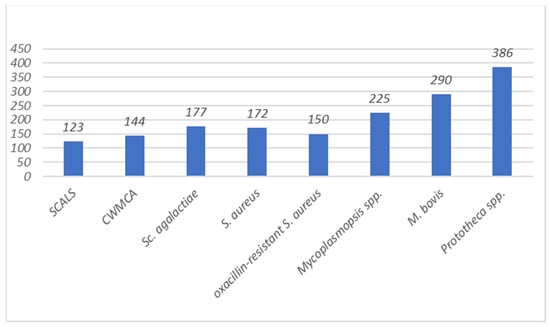
Figure 1
Open AccessOpinion
Reusable Medical Device Pre-Cleaning in Care Units: What Are the Indicators to Prevent Biofilm Formation and Control Occupational Biological Risk?
by
Anaclara F. V. Tipple, Rúbia Lícia R. Sodré, Lais C. Nascimento and Dayane M. Costa
Hygiene 2024, 4(1), 115-121; https://doi.org/10.3390/hygiene4010008 - 20 Mar 2024
Abstract
The pre-cleaning of reusable medical devices is essential for successful cleaning, as it prevents biofilm formation that can compromise disinfection and sterilization. This study aimed to reflect on the recommendations regarding the pre-cleaning of reusable medical devices carried out in care units, such
[...] Read more.
The pre-cleaning of reusable medical devices is essential for successful cleaning, as it prevents biofilm formation that can compromise disinfection and sterilization. This study aimed to reflect on the recommendations regarding the pre-cleaning of reusable medical devices carried out in care units, such as wards, based on recommendations from guidelines/standards related to this important step in reusable medical device reprocessing. However, recommendations for pre-cleaning in care units are not unanimous and contrast with detailed recommendations on reusable medical device reprocessing in the Central Sterile Services Department (CSSD). This topic is an unresolved issue, strongly related to patient and worker safety, which points to the lack of investigations to provide indicators of best practice and highlights the need for shared responsibility management between care units and CSSD.
Full article
(This article belongs to the Section Infectious Disease Epidemiology, Prevention and Control)
Open AccessArticle
Carcinogenic Chemicals in Occupational Settings: A Tool for Comparison and Translation between Different Classification Systems
by
Carolina Zellino, Andrea Spinazzè, Francesca Borghi, Davide Campagnolo, Giacomo Fanti, Marta Keller, Alessio Carminati, Sabrina Rovelli, Andrea Cattaneo and Domenico Maria Cavallo
Hygiene 2024, 4(1), 103-114; https://doi.org/10.3390/hygiene4010007 - 21 Feb 2024
Abstract
In the European Union, Occupational Safety and Health legislation generally refers to European Regulation (CE) n. 1272/2008 to define and classify carcinogens of concern for occupational risk assessment and exposure assessment. In Europe, the current reference is Directive (UE) 2022/431, regarding carcinogen, mutagen,
[...] Read more.
In the European Union, Occupational Safety and Health legislation generally refers to European Regulation (CE) n. 1272/2008 to define and classify carcinogens of concern for occupational risk assessment and exposure assessment. In Europe, the current reference is Directive (UE) 2022/431, regarding carcinogen, mutagen, and reprotoxic agent (CMR) exposure. However, at the worldwide level, different classification approaches are used to establish carcinogenicity of substances and it is often difficult to compare the classifications of carcinogenicity (CoCs) proposed by different international bodies. This study aims to investigate a list of carcinogens of concern in occupational settings based on the CLP (Classification Labelling Packaging) CoC and to create a tool that allows a rapid translation–comparison of some international CoCs with the reference one. CoCs proposed by various sources were consulted and used to apply a translation method, to favor an alignment of different CoCs according to a reference. Results outlined that, considering diverse sources, CoCs can result in different classifications of the same chemicals. Overall, this may have implications for the hazard assessment process, which is the base of risk assessment. The proposed tool is expected to help risk assessors in the occupational field when it is needed to have a comparison with different CoC systems.
Full article
(This article belongs to the Section Occupational Hygiene)
►▼
Show Figures

Figure 1
Open AccessArticle
Antimicrobial Efficacy of a Portable UV-C-Based Coating Activation Device against Candida albicans Biofilm and SARS-CoV-2 as an Additional Feature: An In Vitro Study
by
Adityakrisna Yoshi Putra Wigianto, Megumi Watanabe, Yuki Iwawaki, Takaharu Goto, Tamaki Otsuki and Tetsuo Ichikawa
Hygiene 2024, 4(1), 93-102; https://doi.org/10.3390/hygiene4010006 - 18 Feb 2024
Abstract
This in vitro study aimed to confirm the effect of the additional features of Kirei Keep Light (KKL), a commercial UV-C irradiation system that was originally created for coating the surface of removable dentures with photoreactive 2-methacryloyloxyethyl phosphorylcholine (MPC), on the antimicrobial efficacy
[...] Read more.
This in vitro study aimed to confirm the effect of the additional features of Kirei Keep Light (KKL), a commercial UV-C irradiation system that was originally created for coating the surface of removable dentures with photoreactive 2-methacryloyloxyethyl phosphorylcholine (MPC), on the antimicrobial efficacy aspect against Candida albicans biofilm on a denture base material (PMMA) and SARS-CoV-2. Materials and Methods: The antimicrobial efficacy on C. albicans biofilm was evaluated through quantitative (CFU) and qualitative (SEM images) analysis of three groups: no treatment (control), KKL, and immersion in a disinfectant solution, MCAE. The quantitative evaluation on SARS-CoV-2 was performed by comparing the untreated (control) group and the KKL group. Results: In comparison with the control group (2.39 × 106 CFU/mL), KKL irradiation resulted in a 91.01% reduction in C. albicans biofilm (2.15 × 105 CFU/mL), whereas for the MCAE group, this reduction was 99.98% (4.64 × 102 CFU/mL). The SEM image results also corroborate the CFU results, which showed that the fewest clean surfaces were found in the control, and this gradually increased with KKL and MCAE. SARS-CoV-2 inhibition, indicated by its TCID50 value, demonstrated that KKL almost completely inhibited SARS-CoV-2 infection and replication (99.99% reduction). Conclusion: KKL possesses antimicrobial efficacy on C. albicans biofilm on PMMA and SARS-CoV-2.
Full article
(This article belongs to the Section Oral and Dental Hygiene)
►▼
Show Figures
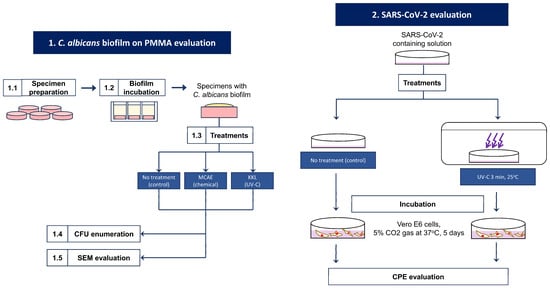
Figure 1
Open AccessArticle
Evaluation of Social-Cognitive Determinants of Patients’ Hand Hygiene Decisions and the Role of Mental Health in a Cross-Sectional and a Longitudinal Study of German Patients
by
Franziska Maria Keller, Alina Dahmen, Lukas Kötting, Christina Derksen and Sonia Lippke
Hygiene 2024, 4(1), 76-92; https://doi.org/10.3390/hygiene4010005 - 01 Feb 2024
Abstract
Patients’ effective hand hygiene helps to reduce healthcare-associated infections and prevents the spread of nosocomial infections and communicable diseases, such as COVID-19. Accordingly, this study aimed to describe effective hand hygiene decisions based on the Health Action Process Approach (HAPA) and whether this
[...] Read more.
Patients’ effective hand hygiene helps to reduce healthcare-associated infections and prevents the spread of nosocomial infections and communicable diseases, such as COVID-19. Accordingly, this study aimed to describe effective hand hygiene decisions based on the Health Action Process Approach (HAPA) and whether this pattern is invariant for mental health. Data were collected cross-sectionally from patients who had previously been admitted to a hospital (Nstudy 1 = 279; study 1) and longitudinally from psychosomatic rehabilitation patients (Nstudy 1 = 1073; study 2). The fit of the HAPA framework and changes in hand hygiene decisions regarding compliance, social-cognitive variables of the HAPA, and mental health status were examined. The results revealed that the trimmed HAPA framework fitted the data well (χ2 = 27.1, df = 12, p < 0.01, CMIN/df = 2.26, CFI = 0.97, RMSEA = 0.08). According to multi-group structural equation modeling, the HAPA model with hand hygiene behavior was found to be invariant regarding mental health. To conclude, the trimmed HAPA framework was revealed to be a generic framework for explaining social-cognitive processes relating to hand hygiene decisions. Therefore, helping individuals to perform hand hygiene recommendations requires intention formation and bridging the intention–behavior gap. This can be undertaken by promoting planning and self-efficacy. All processes appear generic to participants with and without mental health challenges.
Full article
(This article belongs to the Section Health Promotion, Social and Behavioral Determinants)
►▼
Show Figures
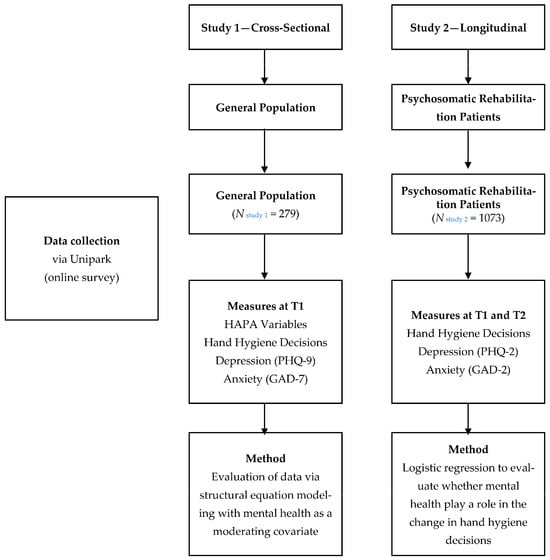
Figure 1
Open AccessArticle
Using Machine Learning to Improve Vector Control, Public Health and Reduce Fragmentation of Urban Water Management
by
Fernanda Klafke, Elisa Henning and Virginia Grace Barros
Hygiene 2024, 4(1), 49-75; https://doi.org/10.3390/hygiene4010004 - 11 Jan 2024
Abstract
►▼
Show Figures
Urban waters (UW) are complex environments, and their definition is related to water systems in urban zones, whether in a natural system or an urban facility. The health of these environments is related to public health and the quality of life because public
[...] Read more.
Urban waters (UW) are complex environments, and their definition is related to water systems in urban zones, whether in a natural system or an urban facility. The health of these environments is related to public health and the quality of life because public health is the focal point of environmental and anthropic impacts. Infrastructure is paramount for maintaining public health and social and economic development sanitation. Insufficient infrastructure favors disease vectors. The population and environment suffer from deficient urban water infrastructure in Brazil despite government efforts to manage the existing systems. In this work, machine learning (regression trees) demonstrates the deficiency of sanitation and UW management fragmentation on public health by using the Aedes aegypti infestation index (HI) and water supply, wastewater, stormwater and drainage indicators (SNIS data). The results show that each Brazilian region faces different problems. The more infested regions were Northeastern, Northern and Southeastern. Moreover, municipalities with better SNIS data have lower infestation rates. Minimizing problems related to sanitation through the integrated management of water and urban areas is extremely important in developing countries. UW governance is connected to public health. Water management fragmentation leads to more complex issues, and managers must confront them to improve the quality of life in urban zones.
Full article
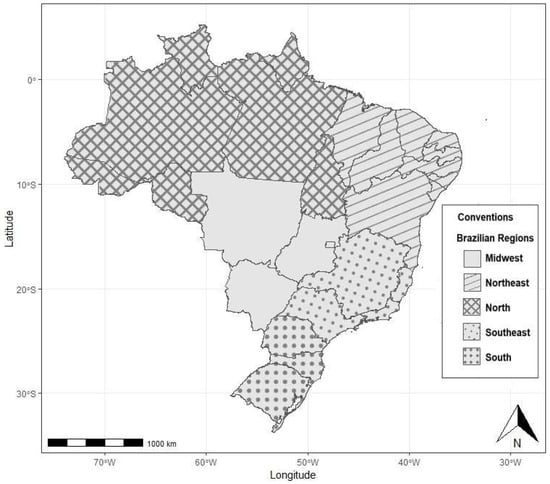
Figure 1
Open AccessSystematic Review
Does COVID-19 Vaccination Protect Contact Persons? A Systematic Review
by
Günter Kampf
Hygiene 2024, 4(1), 23-48; https://doi.org/10.3390/hygiene4010003 - 09 Jan 2024
Abstract
The protective effect of COVID-19 vaccination for contact persons is controversial. Therefore, the aim of this review was to determine whether COVID-19 vaccination provides significant protection for them. A PubMed search was carried out using the terms “unvaccinated vaccinated covid” in combination with
[...] Read more.
The protective effect of COVID-19 vaccination for contact persons is controversial. Therefore, the aim of this review was to determine whether COVID-19 vaccination provides significant protection for them. A PubMed search was carried out using the terms “unvaccinated vaccinated covid” in combination with “viral load” and “transmission”. Studies were included if they reported original comparative data on the SARS-CoV-2 viral load, duration of SARS-CoV-2 detection, or SARS-CoV-2 transmission rates. A total of 332 articles were identified, of which 68 were included and analyzed. The differences in the viral load were equivocal in 57% of the 35 studies, significantly lower in the vaccinated in 11 studies and in the unvaccinated in 3 studies. The infectious virus levels were significantly lower in the vaccinated in two out of six studies. Virus clearance was significantly faster in vaccinated subjects in two of eight studies (detection of viral RNA) and two of four studies (detection of infectious virus). The secondary attack rates were significantly lower in vaccinated index cases in 6 of 15 studies. The vaccination status of contacts was described in two of the six studies and was 31.8% and 39.9% lower in households with an unvaccinated index case. The inconsistent and variable differences in the viral load, viral clearance and secondary attack rates between vaccinated and unvaccinated individuals, especially during the omicron predominance, suggests that COVID-19 vaccination is unlikely to prevent a relevant proportion of transmissions to contact persons, taking into account the relevance of the immunological status of the contact population (vaccination rates and previous infection).
Full article
(This article belongs to the Section Public Health and Preventive Medicine)
►▼
Show Figures
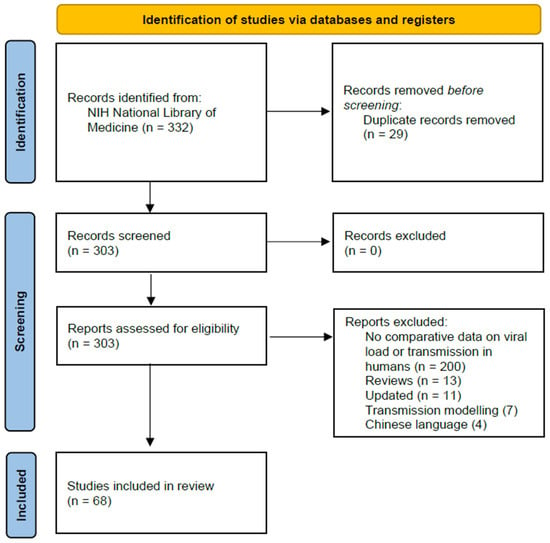
Figure 1
Open AccessSystematic Review
Maternal Handwashing with Soap Practices and Associated Risk Factors in Nepal: A Systematic Review
by
Shalik Ram Dhital, Catherine Chojenta, Tanmay Bagade and Deborah Loxton
Hygiene 2024, 4(1), 14-22; https://doi.org/10.3390/hygiene4010002 - 08 Jan 2024
Abstract
Handwashing with soap is a fundamental practice for preventing communicable diseases, particularly in resource-constrained settings like Nepal, where various factors influence maternal handwashing behaviours. A systematic search encompassing PubMed/Medline, Embase, PsycINFO, CINAHL and grey literature source was conducted. Extracted eligible articles underwent descriptive
[...] Read more.
Handwashing with soap is a fundamental practice for preventing communicable diseases, particularly in resource-constrained settings like Nepal, where various factors influence maternal handwashing behaviours. A systematic search encompassing PubMed/Medline, Embase, PsycINFO, CINAHL and grey literature source was conducted. Extracted eligible articles underwent descriptive analysis and their quality assessment was carried out following STROBE guidelines. From the initial screening of 187 database articles and 18 from grey literature, a total of 120 full text articles and records were retrieved to evaluated for inclusion in the review, identifying nine articles meeting the inclusion criteria for the review. Maternal handwashing with soap frequencies varied during critical moments ranging from 6% to 100%, and a 47% availability of soap and water at the household level was reported. Factors influencing handwashing included education, wealth, ecology, and participation in health promotion campaigns. Barriers included knowledge gaps, contrary beliefs, unavailability of soap and water, financial constraints, maternal demotivation, and low participation in decision-making. Limitations include study design heterogeneity (cross-sectional, Randomized Controlled Trials-RCT, Cohort), sample size variability, and geographical bias, potentially limiting generalizability of this study, limited reporting on soap and water availability for mothers at the household level is noted, and temporal variability introduces study inconsistency. Availability of soap, water, and effective health education is crucial for promoting sustained handwashing practices. Community-based interventions involving mothers in decision making and policy initiatives are essential for overcoming barriers and promote behavioural change to improve public health outcomes. This paper aims to determine the rates of handwashing with soap among mothers in Nepalese households and explore the factors associated with the uptake of handwashing.
Full article
(This article belongs to the Section Health Promotion, Social and Behavioral Determinants)
►▼
Show Figures
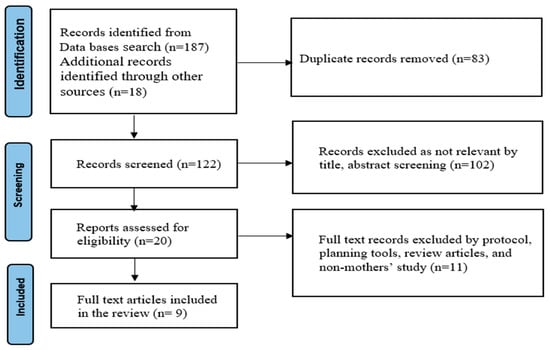
Figure 1
Open AccessArticle
Why Do Physicians in Japan Use e-Cigarettes and/or Heated Tobacco Products? A Cross-Sectional Survey
by
Yuichiro Otsuka, Yoshitaka Kaneita, Osamu Itani and Yuuki Matsumoto
Hygiene 2024, 4(1), 1-13; https://doi.org/10.3390/hygiene4010001 - 23 Dec 2023
Abstract
►▼
Show Figures
Background: The tobacco industry has actively advocated for electronic cigarettes (e-cigarettes) and heated tobacco products (HTPs) as harm-reduction alternatives to traditional cigarettes. Around 40% of smoking physicians have adopted HTPs. This study aimed to uncover the motivations behind Japanese physicians’ e-cigarette and HTP
[...] Read more.
Background: The tobacco industry has actively advocated for electronic cigarettes (e-cigarettes) and heated tobacco products (HTPs) as harm-reduction alternatives to traditional cigarettes. Around 40% of smoking physicians have adopted HTPs. This study aimed to uncover the motivations behind Japanese physicians’ e-cigarette and HTP use while analyzing the associations between product use, physician demographics, lifestyles, and smoking preferences. Methods: A mail-based survey was conducted in 2020, targeting 6000 male and 1500 female physicians. From the 5492 survey participants, 346 physicians aged 28 to 98 who were current smokers were selected. The survey assessed their usage of e-cigarettes and HTPs and explored the reasons for initial adoption. A multivariate logistic regression analysis examined the relationships between product use, physician characteristics, and behaviors. Results: Approximately 33.8% of smoking physicians had experimented with e-cigarettes and HTPs. E-cigarette and HTP use correlated with youthfulness, nicotine addiction, and a history of medical treatment. The primary drivers for adopting e-cigarettes and HTPs were reduced odor (74.4%), perceived harm reduction (48.7%), and decreased exposure to secondhand smoke (29.1%). Conclusions: Physicians, when transitioning from conventional cigarettes to HTPs or e-cigarettes, are primarily motivated by a desire to reduce the odor of conventional cigarettes rather than health-related concerns.
Full article

Figure 1
Open AccessArticle
Improving Health Literacy of Domestic Household Disinfection Use: Readability of Consumer-Facing Information on Domestic Household Disinfectant Products on Sale in the UK—An Infodemiology Study
by
John E. Moore and Beverley C. Millar
Hygiene 2023, 3(4), 492-502; https://doi.org/10.3390/hygiene3040036 - 02 Dec 2023
Abstract
Disinfectants purchased from retail outlets form the cornerstone of infection control and prevention within the domestic household. The growing utilisation of the concept of “hospital-at-home” places greater emphasis on domestic disinfection by the householder in helping to prevent the acquisition of infections within
[...] Read more.
Disinfectants purchased from retail outlets form the cornerstone of infection control and prevention within the domestic household. The growing utilisation of the concept of “hospital-at-home” places greater emphasis on domestic disinfection by the householder in helping to prevent the acquisition of infections within the home. No reports or data exist that indicate how readable the information provided on disinfectants is, which would help householders use disinfectants optimally. The aim of this study was therefore to quantitatively examine the readability (Flesch Reading Ease; Flesch–Kinkaid Grade Level; text metrics) of consumer (public)-facing information (n = 108) of domestic household disinfectants sourced from (i) UK high street supermarket chains (n = 4) and (ii) disinfectant manufacturers (n = 6). The readability of all supermarket and manufacturer information (n = 108) gave a mean Flesch Reading Ease score of 51.7 (target ≥ 60) and a Flesch–Kinkaid Grade Level score of 8.1 (target ≤ 8), thereby failing to achieve readability reference target values. Authors preparing information on the domestic use of disinfectants should be aware of the value of quantitative readability metrics and online tools to help support their writing of such information in order to produce materials which are within target readability values, thereby further supporting health literacy in this population and disinfectant efficacy.
Full article
(This article belongs to the Section Hygiene Policy, Regulation, and Practice)
►▼
Show Figures
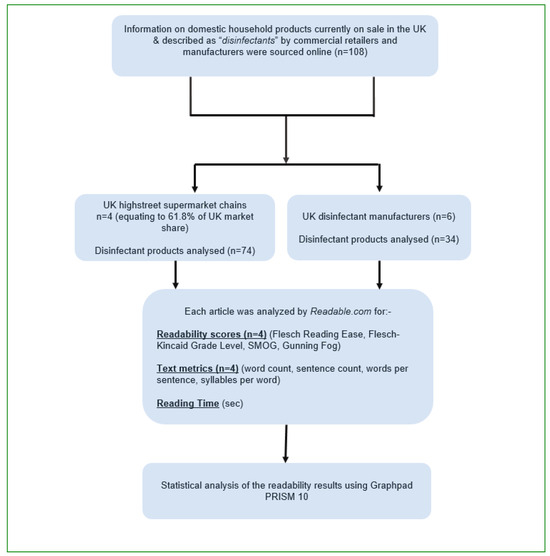
Figure 1
Open AccessArticle
Multi-Level Perceptions on Higher Education Development for Sanitation and Hygiene Management in Nigeria
by
Peter Emmanuel Cookey, Mayowa Abiodun Peter-Cookey, Iloma Unwobuesor Richard and Damir Brdanovic
Hygiene 2023, 3(4), 465-491; https://doi.org/10.3390/hygiene3040035 - 23 Nov 2023
Abstract
Providing safely managed sanitation/hygiene requires key competencies for education, training, service delivery, enterprise development and management, product and infrastructure design and development, construction and installation, governance, financing, research, etc. These strategic sanitation capacities will have to be built from higher education’s academic and
[...] Read more.
Providing safely managed sanitation/hygiene requires key competencies for education, training, service delivery, enterprise development and management, product and infrastructure design and development, construction and installation, governance, financing, research, etc. These strategic sanitation capacities will have to be built from higher education’s academic and professional programmes structured and designed to produce skilled and knowledgeable professionals and practitioners. This study aims to investigate the quality of the sanitation/hygiene management content of Environmental Health programmes; the adequacy of the existing central curricula; and the perception of environmental health sanitation/hygiene-trained professionals to determine the next phase for building knowledge and capacity of sanitation professionals in Nigeria through higher education institutions. A multi-level mixed method concurrent study was used for sampling and data collection with a multi-level perception analysis to examine the perceptions of students, lecturers and graduate alumni, as well as employers/supervisors and clients/service users of sanitation/hygiene-related graduates. The main findings of this paper show a limited understanding of the concepts of contemporary issues of sanitation/hygiene management like sustainable sanitation, citywide inclusive sanitation, regenerative sanitation, circular bioeconomy, etc.; the central/national teaching and curricula were found to be seriously out of date; and clients/service users were dissatisfied with the skills and knowledge levels of the graduates. The study concludes by recommending a national sanitation management higher education pathway to guide the provision of integrated sanitation/hygiene management education at higher education institutions (HEIs), to build an effective, efficient, competent and sufficient workforce for the country.
Full article
(This article belongs to the Section Environmental Health)
►▼
Show Figures
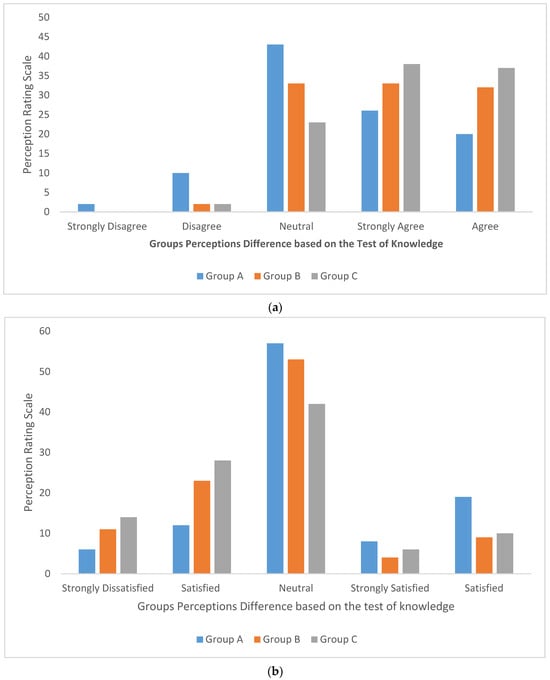
Figure 1
Open AccessArticle
Microbial Load of Hand Sanitizer Dispensers—A University Hospital Study
by
Christos Stefanis, Elpida Giorgi, Elisavet Stavropoulou, Chrysoula (Chrysa) Voidarou, Maria Skoufou, Aikaterini Nelli, Athina Tzora, Christina Tsigalou and Eugenia Bezirtzoglou
Hygiene 2023, 3(4), 450-464; https://doi.org/10.3390/hygiene3040034 - 13 Nov 2023
Abstract
Hospital-acquired infections are a significant concern in healthcare settings, leading to patient safety risks, increased morbidity and mortality, and financial burdens. Hand hygiene is crucial in preventing the spread of bacteria in hospitals and communities. Manual hand sanitizer dispensers can harbor presumptive pathogenic
[...] Read more.
Hospital-acquired infections are a significant concern in healthcare settings, leading to patient safety risks, increased morbidity and mortality, and financial burdens. Hand hygiene is crucial in preventing the spread of bacteria in hospitals and communities. Manual hand sanitizer dispensers can harbor presumptive pathogenic bacteria and act as fomites for bacterial transmission. This study aimed to assess the microbial contamination of manual hand sanitizer dispensers in a hospital setting and to study their antibiotic resistance profiles. Samples were collected using sterile cotton swabs and then inoculated into brain heart infusion broth. Subsequent subcultures were performed on both blood and MacConkey agar. The isolates were then identified using the Bruker MALDI Biotyper (Bruker Daltonik, Bremen, Germany) to the species level. Sampling was conducted in various wards and in the hospital and the University areas on dispenser levers and nozzle areas. The results showed that all samples yielded one or more bacterial species. Bacterial isolates identified belonged to species commonly found on the skin microflora and some Gram-negative enteric bacilli. Higher colonization was observed on the dispenser lever. Among Gram+ microorganisms, most bacterial species were shown to be sensitive to β-lactams, with the exception of Staphylococcus spp., resistant to AMP (Ampicillin) and Penicillin. However, no Methicillin resistant isolates were detected. Gram− microorganisms such as Pseudomonas luteola were shown to be sensitive to all tested antibiotics, while Pantoea agglomerans was shown to be resistant to AMC (amoxicillin–clavulanic acid). Rifampicin tested only against Bacilli showed resistance. Based on the findings, it is recommended to implement systematic cleaning and proper maintenance of manual dispenser areas or to use automated dispensers to reduce hand contact and minimize microbial contamination. Monitoring the presence of microorganisms in hand sanitizing gels and dispensers is an essential infection control strategy.
Full article
(This article belongs to the Section Hygiene in Healthcare Facilities)
►▼
Show Figures
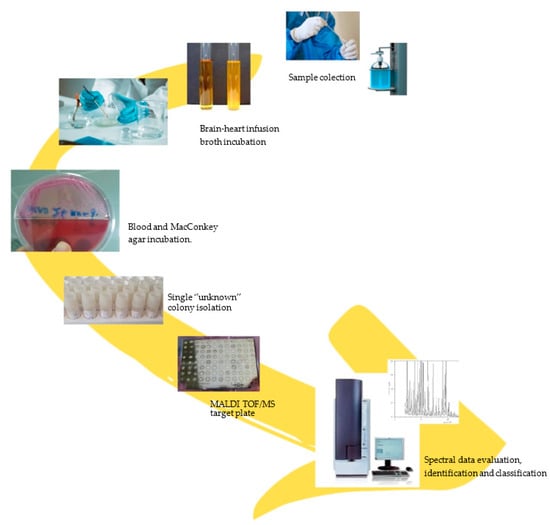
Figure 1
Open AccessOpinion
Pathogen Pollution: Viral Diseases Associated with Poor Sanitation in Brazil
by
Joel Henrique Ellwanger and José Artur Bogo Chies
Hygiene 2023, 3(4), 441-449; https://doi.org/10.3390/hygiene3040033 - 06 Nov 2023
Cited by 1
Abstract
►▼
Show Figures
Brazil faces many types of pollution, including atmospheric CO2 pollution due to Amazon deforestation, pollution by heavy metals, microplastics, pesticides, pathogens, and other classes of environmental contaminants. Pathogen pollution refers to (I) the introduction of a pathogen to a new host species
[...] Read more.
Brazil faces many types of pollution, including atmospheric CO2 pollution due to Amazon deforestation, pollution by heavy metals, microplastics, pesticides, pathogens, and other classes of environmental contaminants. Pathogen pollution refers to (I) the introduction of a pathogen to a new host species or population and (II) a concept used in the study of pathogenic organisms in water or terrestrial ecosystems. Anthropogenic activities are the leading forces of pathogen pollution in both contexts previously cited. In this Opinion article, we discuss the impacts of pathogen pollution on public health, infectious diseases emergence, and ecosystems using mosquito- and water-borne viral diseases in Brazil as case studies. Finally, we advocate improvements and expansion in sanitation systems, considering sewage treatment and soil waste management, as an umbrella factor to minimize risks and spreading of pathogen pollution in Brazil.
Full article
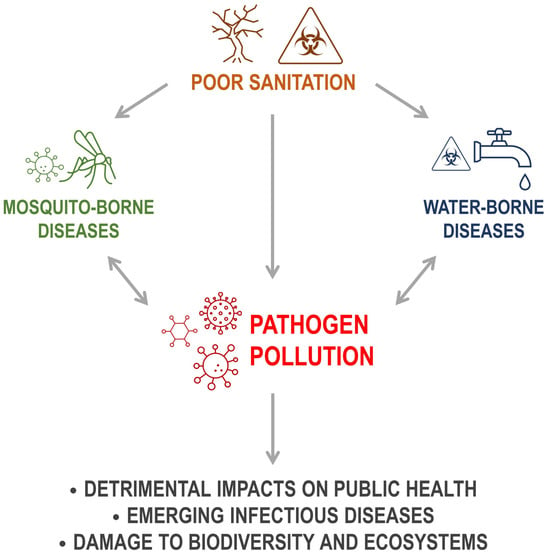
Figure 1
Open AccessArticle
A Cross-Over Randomized Controlled Clinical Trial for Evaluation of Two Hygiene Protocols on Microbial Load, Tissue Health, and Opinion of Ocular Prosthesis Wearers
by
Laís Ranieti Makrakis, Adriana Barbosa Ribeiro, Letícia de Sá Evelin, Viviane de Cássia Oliveira, Ana Paula Macedo, Evandro Watanabe and Cláudia Helena Silva-Lovato
Hygiene 2023, 3(4), 428-440; https://doi.org/10.3390/hygiene3040032 - 03 Nov 2023
Abstract
►▼
Show Figures
The recommendations for the wear and hygiene of ocular prostheses can vary among practitioners, and it is still a controversial theme in the literature. This clinical trial evaluated the microbial load, tissue health of the socket, and the participants’ opinions before and after
[...] Read more.
The recommendations for the wear and hygiene of ocular prostheses can vary among practitioners, and it is still a controversial theme in the literature. This clinical trial evaluated the microbial load, tissue health of the socket, and the participants’ opinions before and after the use of two hygiene protocols. Thirty ocular prosthesis wearers used either a Daily Protocol (DPt: hygiene once a day) or Weekly Protocol (WPt: hygiene once a week) for 5 weeks with a washout of 7 days. The microbial load was quantified by the colony-forming unit count of the aerobic bacteria, Candida spp., Staphylococcus spp., and Gram-negative bacteria. The tissue health of the socket was evaluated by scores, and patients’ opinion of the protocols was evaluated using the analogic visual scale (VAS). Data were analyzed by ANOVA Repeated Measures, Friedman, Cochran’s Q Test, Wilcoxon, Fisher, and Pearson’s chi-square tests considering p < 0.05. There was no difference in the microbial load of the microorganisms (p > 0.05). Both protocols improved socket inflammation (p = 0.005) and discharge (p < 0.001); DPt improved edema (p = 0.021) and crusting (p = 0.020). There was no difference in patients’ rating responses (VAS) for all the questions of patients’ opinion (Q1: p = 1.0; Q2: p = 1.0; Q3: p = 1.0; Q4: p = 1.0; Q5: p = 1.0; Q6: p = 0.317; Q7: p = 1.0; Q8: p = 0.159). There was a correlation between eye drops/edema (p = 0.030), eye drops/pain (p = 0.016), microbial load with discharge, inflammation, eyelid edema, and pain. Inflammation was correlated with edema at baseline (p < 0.001) and after DPt (p = 0.018), and with crusting at baseline (p = 0.003); edema was correlated with crusting at baseline (p < 0.001); crusting was correlated with discharge after WPt (p < 0.001). The protocols showed no effects on the microbial load of the anophthalmic socket and ocular prosthesis. However, better tissue health and patient acceptance were observed after both regimens.
Full article
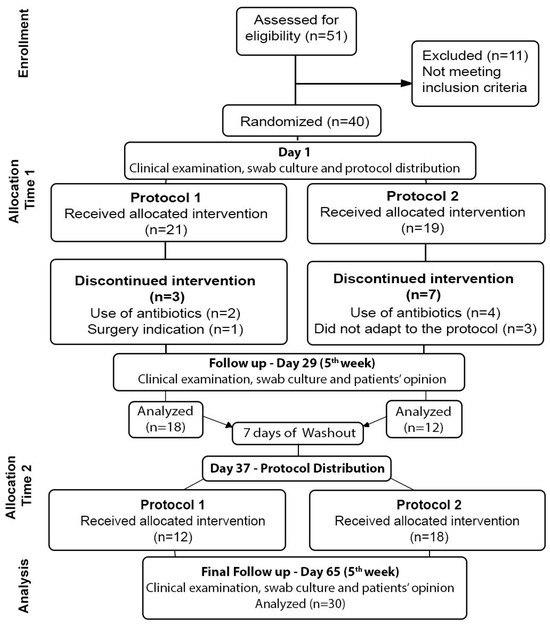
Figure 1
Open AccessArticle
Measuring the Self-Efficacy of Health Professionals in Hand Hygiene and Glove Usage during the COVID-19 Pandemic: A Brazilian Multicenter Observational Survey
by
Tatiana Areas da Cruz, André Pereira dos Santos, Jéssica Fernanda Corrêa Cordeiro, Daniella Corrêa Cordeiro, Ludmila Albano de Felice Gomes, Viviane de Cássia Oliveira, Eliana Borges Silva Pereira, Andréa Mara Bernardes da Silva, Adriana Barbosa Ribeiro, Cláudia Helena Lovato da Silva, Denise de Andrade and Evandro Watanabe
Hygiene 2023, 3(4), 416-427; https://doi.org/10.3390/hygiene3040031 - 01 Nov 2023
Abstract
In social cognitive theory, self-efficacy refers to the belief of a person in their own capacity to successfully perform certain tasks or behaviors. This study measured the self-efficacy of health professionals in hand hygiene (HH) and glove usage (GU) during the COVID-19 pandemic.
[...] Read more.
In social cognitive theory, self-efficacy refers to the belief of a person in their own capacity to successfully perform certain tasks or behaviors. This study measured the self-efficacy of health professionals in hand hygiene (HH) and glove usage (GU) during the COVID-19 pandemic. It was an observational Brazilian multicenter study with a cross-sectional design with an online application of an instrument measuring the self-efficacy of health professionals in HH and GU. Health professionals (n = 193) participated in this study: 96 (49.7%) were nursing professionals, 38 (20.2%) were dental professionals, 21 (10.9%) were physicians, 10 (5.2%) were pharmacists, and 27 (14.0%) were other health professionals. Regarding the instrument applied, the maximum score (100 points) was achieved by 167 (86.5%) participants on Question 2 (confidence in regular routine behaviors), and the lowest scores achieved were 0, 10, 30, 40, and 50 points, referring to 18 (9.3%) participants, on Question 14 (the influence of management’s conduct related to practices). A total of 64.1% dental professionals, 57.1% of physicians, 39.6% of nurses, 20.0% of pharmacists, and 55.6% of other health professionals were classified as having self-efficacy. There was only a significant association between being a dental professional and having self-efficacy regarding HH and GU during the COVID-19 pandemic in relation to other health professional categories.
Full article
Open AccessArticle
Atmospheric Plasma Sources as Potential Tools for Surface and Hand Disinfection
by
Wolfram M. Brück, Alain Savary, Martine Baudin, Martine Emery Mabillard and Gilles Courret
Hygiene 2023, 3(4), 406-415; https://doi.org/10.3390/hygiene3040030 - 26 Oct 2023
Abstract
►▼
Show Figures
Good hand hygiene has proven to be essential in reducing the uncontrolled spread of human pathogens. Cold atmospheric plasma (CAP) may provide an alternative to disinfecting hands with ethanol-based handrubs when handwashing facilities are unavailable. CAP can be safely applied to the skin
[...] Read more.
Good hand hygiene has proven to be essential in reducing the uncontrolled spread of human pathogens. Cold atmospheric plasma (CAP) may provide an alternative to disinfecting hands with ethanol-based handrubs when handwashing facilities are unavailable. CAP can be safely applied to the skin if the energy is well controlled. In this study, radio frequency (RF) and direct current (DC) plasma sources were built with a pin-to-mesh electrodes configuration inside a fused silica tube with a 5 mm inner diameter. Microbiological assays based on EN 13697:2015+A1:2019 using Escherichia coli DSM 682 or Staphylococcus epidermidis DSM 20044 were used to examine the antimicrobial effect of various plasma conditions. Metal and silicone disks that model skin were used as inoculation matrices. The prototype air RF CAP achieved significant disinfection in the MHz range on stainless steel and silicone substrates. This is equivalent to half the performance of direct current CAP, which is only effective on conductive substrates. Using only electricity and air CAP could, with further optimization to increase its efficacy, replace or complement current hand disinfection methods, and mitigate the economic burden of public health crises in the future.
Full article
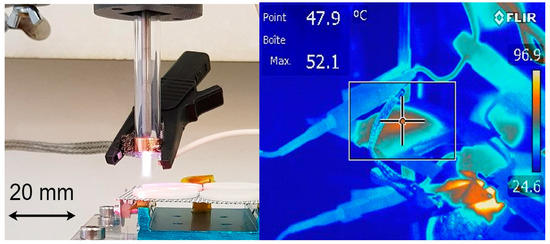
Figure 1
Open AccessArticle
COVID-19, Housing, and Environmental Injustice
by
Anuli Njoku and Marcelin Joseph
Hygiene 2023, 3(4), 396-405; https://doi.org/10.3390/hygiene3040029 - 24 Oct 2023
Abstract
In the United States, there has been a long history of environmental injustice that disproportionately affects racial and ethnic minorities and low-income communities due to racially targeted policies and widespread discrimination. Environmental racism can be revealed in housing discrimination that perpetuates inequities in
[...] Read more.
In the United States, there has been a long history of environmental injustice that disproportionately affects racial and ethnic minorities and low-income communities due to racially targeted policies and widespread discrimination. Environmental racism can be revealed in housing discrimination that perpetuates inequities in exposure to environmental pollutants. Biased credit and mortgaging practices such as redlining have led to housing segregation of racial and ethnic minorities in the USA, permitting policymakers to diminish and disinvest in these communities. The COVID-19 pandemic has amplified housing instability for families of color, including Black and Hispanic/Latinx communities, putting them at increased risk for COVID-19 exposure. There is a need to investigate how environmental injustice intensifies the COVID-19 pandemic, illuminates racial and ethnic inequities in exposure to environmental contaminants, and fuels disparities in COVID-19 outcomes. The aims of this paper are to analyze and discuss environmental injustice and racial and ethnic disparities related to COVID-19 and housing. We also propose recommendations to address this pervasive issue.
Full article
(This article belongs to the Special Issue COVID-19: Health and Hygiene)
Highly Accessed Articles
Latest Books
E-Mail Alert
News
Topics
Topic in
Healthcare, Hygiene, JCM, Life, Sports
Physical Exercise Impacts on Human Physical and Psychological Health
Topic Editors: Xueqiang Wang, Li Li, Li HuDeadline: 30 June 2025

Conferences
Special Issues
Special Issue in
Hygiene
The Challenge of Disinfection and Sterilization in Veterinary Practice
Guest Editors: Ana Cláudia Coelho, Luís Cardoso, Paula OliveiraDeadline: 20 May 2024
Special Issue in
Hygiene
Emerging Biocide Resistance–Frequency, Drivers, Relevant Outcomes and Containment Strategies
Guest Editor: Günter KampfDeadline: 31 July 2024
Special Issue in
Hygiene
Current Trends and New Challenges in Occupational Medicine and Industrial Hygiene
Guest Editors: Andrea Cattaneo, Giovanni De Vito, Davide Campagnolo, Francesca BorghiDeadline: 31 October 2024




